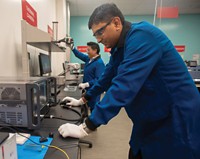Advertisement
Grab your lab coat. Let's get started
Welcome!
Welcome!
Create an account below to get 6 C&EN articles per month, receive newsletters and more - all free.
It seems this is your first time logging in online. Please enter the following information to continue.
As an ACS member you automatically get access to this site. All we need is few more details to create your reading experience.
Not you? Sign in with a different account.
Not you? Sign in with a different account.
ERROR 1
ERROR 1
ERROR 2
ERROR 2
ERROR 2
ERROR 2
ERROR 2
Password and Confirm password must match.
If you have an ACS member number, please enter it here so we can link this account to your membership. (optional)
ERROR 2
ACS values your privacy. By submitting your information, you are gaining access to C&EN and subscribing to our weekly newsletter. We use the information you provide to make your reading experience better, and we will never sell your data to third party members.
Specialty Chemicals
Breen fine-tunes DuPont R&D strategy ahead of DowDuPont split
Moonshots are out, but future chair isn’t averse to all long-term R&D
by Alex Tullo
March 13, 2019
| A version of this story appeared in
Volume 97, Issue 11

R&D will be a key strength of the new DuPont, but projects will need to have strong business cases to survive, Ed Breen, current CEO of DowDuPont and future executive chairman of DuPont, told an audience in New York City last week.
At a March 7 event organized by the Chemical Marketing & Economics Group of the American Chemical Society, Breen outlined the role research will play at the future DuPont, which is set to separate from DowDuPont on June 1 along with agricultural chemical maker Corteva Agriscience. Dow will reemerge as an independent company on April 1.
The new DuPont will have businesses in advanced polymers, electronics, construction, and nutrition and biosciences. In all, it will spend about $900 million annually on R&D, Breen said.
Breen has been outspoken about his aversion to “moonshot” R&D projects, which he has said are costly and uncertain to succeed commercially. Instead, he favors more modest R&D initiatives driven by customer needs.
The executive elaborated on his position at the event. “I am not against the long-term project at all,” he insisted. “What I was against was when I got to DuPont, we were spending $220 million in an organization called Central R&D that had no P&L”—profit and loss responsibility—“wasn’t tied to a business, and wasn’t tied to an industry,” he said.
Breen moved to close Central R&D at the end of 2015 and push R&D closer to the firm’s business segments. “I don’t want to just have everyone playing in the sandbox and doing the moonshots,” he said. “And that $220 million, I’d rather embed it in a business.”
The new DuPont will be disciplined in how it spends money in R&D and will track project progress “maniacally,” Breen said. “Not every project is going to work. That’s fine. Maybe 20% don’t work, but you need to learn when to kill them.”
Some projects don’t die, he warned. “Even when you think you killed it, 20 people go off in a corner and they keep working on it for five more years.”





Join the conversation
Contact the reporter
Submit a Letter to the Editor for publication
Engage with us on Twitter